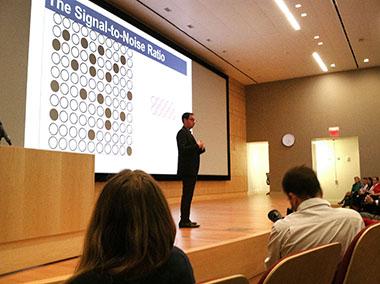Nate Silver, a statistician and author of the Five Thirty Eight New York Times blog, spoke to more than 350 students, faculty and staff members Thursday in the Hunt Library on Centennial Campus. The N.C. State department of statistics and SAS, a Raleigh-based software company, hosted the lecture Celebrating Statistics: The Signal and the Noise, which covered how big data is influencing our society.
Before Silver’s lecture began, the audience heard from Chancellor Randy Woodson, Montserrat Fuentes, the head of the statistics department, John Saul, the executive vice president of SAS, and Marie Davidian, the president of the American Statistical Association.
“I feel very confident with Nate Silver here,” Woodson said. “I feel like we can predict anything.”
Silver’s visit to N.C. State is part of a worldwide commemoration of 2013 as the International Year of Statistics, which is being celebrated by more than 2,100 organizations including the ASA.
“This is the year to celebrate the field of statistics, a field that has grown increasingly important to our modern world,” Saul said in his opening remarks.
Silver’s lecture started with some of the problems he sees in the increasing amount of big data available to businesses and political organizations. With an increasing amount of communication channels today, people have more options to watch slanted media. Only 1 percent of Rachel Maddow’s audience is Republican, Silver said.
“More information ought to be good, but not when it gives you the ability to tell yourself what you want to hear,” Silver said.
Silver also said as statisticians increase the volume of data, the complexity of relationships increases. This sometimes can lead to mistakenly viewing correlation as causation.
As an example, Silver said many people once thought the Super Bowl outcome could predict Wall Street’s performance each fall. If a National Football Conference team won, Wall Street would perform well. However, if an Atlantic Football Conference team won, Wall Street would experience a bearish market. Yet in 2008, the New York Giants, an NFC team, won, and Wall Street experienced the worst performance since the Great Depression.
“More data means we have a widening gap between what we really know and what we think we know,” Silver said.
Silver said the second problem he sees is the false detection of meaning in random data. This leads to people creating algorithms, most often for stock performances, with absolutely no meaning.
“People have a tendency to hear patters in random noise,” Silver said.
Silver said it’s important to add a human element to statistics.
“Computers are really fast but dumb,” Silver said. “People are not as fast but intelligent. That’s why we need folks like to you work with our data to produce intelligent insights.”
Silver said he thinks statisticians can employ several good habits when interpreting statistics. These include thinking probabilistically, recognizing history, staying aware of potential biases and continually trying despite possibility of failure.
Statisticians have to think about margins of error, Silver said, using meteorologists as an example because they use probabilities to predict temperature patterns or hurricane paths.
“We can’t understand the entire weather system all by ourselves,” Silver said. “But weathermen have gotten very good.”
After his lecture, Silver responded to questions from the audience, commenting about statisticians’ roles in the media and giving advice to current statistics students. He said good statisticians should be aggressive and able to communicate well.








